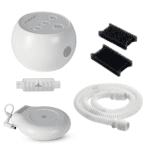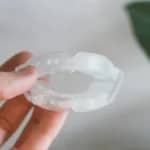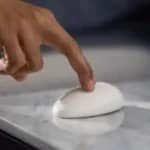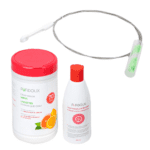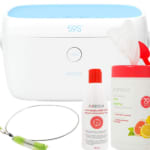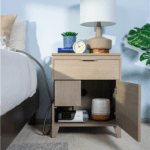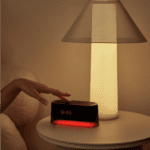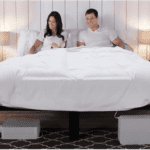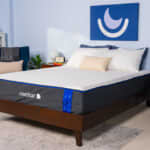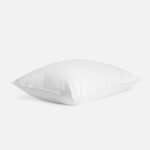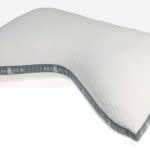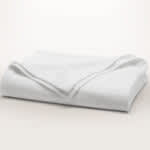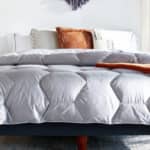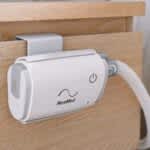Hybrid mattresses combine elements of two or more mattress types to promote a more balanced performance. Mattresses are split into the top part that you lay on, which we call the comfort system, and the base of the bed, known as the support core. The comfort systems of hybrid beds may use memory foam, polyfoam, latex, microcoils, or a combination of these materials, while their cores generally consist of responsive coil systems. Components shape how a mattress feels, so understanding the construction of hybrid models is helpful for anyone in the market for a new mattress.
We generally recommend hybrid mattresses for sleepers who value the breathability, responsiveness, and edge support of an innerspring model but still want the pressure relief and motion isolation of other popular designs, like foam. We’ll break down what you should know about hybrid models to decide if this mattress type is right for you.
How a Hybrid Mattress Is Constructed
A hybrid mattress has its name because it incorporates aspects of other mattress types in one model, containing a distinct comfort system of certain materials and a support core of differing materials.
The comfort system plays a major role in contouring, motion isolation, and temperature control. Like an all-foam mattress, the comfort layers in a hybrid may contain polyfoam or memory foam. Like a latex model, it may use Talalay or Dunlop latex. It may also contain microcoils, which are fairly unique to hybrid designs.
Meanwhile, a hybrid’s support core adds edge support, stability, bounce, and breathability. Hybrid cores usually consist of pocketed coils. However, some designs use other types of springs.
Comfort System
Within the category of hybrids, there are several subtypes determined by the materials used in the comfort system. Each of these materials impacts mattress performance.
- Memory Foam: Memory foam comfort systems often enhance a hybrid’s motion isolation and pressure relief by conforming closely to the sleeper. However, memory foam can also make a mattress harder to move around on, and models without materials designed for cooling may retain heat.
- Polyfoam: Polyfoam cushions and contours without the close hug of memory foam. Hybrid mattresses with polyfoam comfort systems usually relieve pressure and isolate motion well, though often not to the same extent as memory foam. That said, they tend to be easier to move on and less prone to heat retention.
- Latex: Latex hybrid mattresses contain Dunlop, Talalay, or synthetic latex comfort systems. Hybrids with latex comfort systems tend to be highly responsive and temperature regulating, but they also traditionally carry a steeper price tag.
- Microcoils: Some hybrids contain microcoils, which are extra small coils used in the comfort system for contouring, breathability, and responsiveness. Many use pocketed microcoils that move independently of each other, improving motion isolation. However, this type of comfort system is relatively uncommon and may produce noise as it ages.
- Other materials: Less commonly, comfort systems contain a pillow top or quilted layer containing other materials that add softness and breathability to a bed. For example, a hybrid could contain a layer with wool, cotton, or polyester in addition to its other comfort layers.
Support Core
The type of coil used in a hybrid’s core can influence its performance, including motion isolation, contouring, edge support, and durability.
- Pocketed Coils: Most hybrid models use pocketed coils, which are metal coils individually encased in fabric that move independently of each other for greater motion isolation and contouring.
- Offset Coils: Offset coils have an hourglass shape and are connected to each other with spiral-shaped wires. With squared tops and bottoms, these coils can flex like a hinge under pressure, increasing responsiveness while limiting motion transfer.
- Bonnell Coils: This traditional type of coil system uses hourglass-shaped springs connected with internal and perimeter wires. While Bonnell coils tend to be supportive and cost effective, they also frequently transfer motion and produce noise.
- Continuous Coils: Rather than containing separate coils, continuous coil systems use one continuous piece of wire twisted into rows and connected by spiraled wires. While these systems are typically durable and budget-friendly, our testers often find they have limited contouring and motion isolation.
Hybrid vs. Innerspring Mattress
The terms hybrid and innerspring are often used interchangeably, but there are notable differences between these two designs. Whereas innerspring mattresses consist primarily of a coil core with little to no comfort system, hybrid models pair a notable comfort system with a coil core. This design difference typically gives hybrids superior motion isolation and pressure relief compared to innerspring models. Innerspring models also tend to use offset, bonnell, and continuous coil springs more often, while hybrids tend to use pocketed coils.
Benefits of a Hybrid Mattress
The best hybrid mattresses frequently earn high marks across performance categories in our in-house testing. However, they usually stand out most for their responsiveness, breathability, contouring, durability, and edge support.
- Easy to move around on: Thanks to their bouncy coil cores, sleepers generally find hybrid mattresses easier to move on than all-foam models. This is particularly likely with latex hybrids due to their buoyant comfort systems. Active sleepers and those with mobility issues may appreciate the responsive design.
- Air flows easily through the coils: Even if a hybrid’s comfort system uses materials prone to heat retention, ample air circulation through the coil core keeps the surface cooler than many all-foam constructions. Models that use comfort systems of foam designed for cooling or breathable latex are often top picks for hot sleepers.
- Balanced contouring and support: With the right firmness for you, a hybrid model may have an exceptional combination of contouring and support. While the comfort system shapes to the body to limit pressure buildup, the coil core helps promote spinal alignment. Many hybrids also use zoning for more targeted support.
- Durable construction: On average, hybrids are among the most durable mattress types. This is particularly true of models that use high-quality materials, such as natural latex and pocketed coils.
- Sturdy edge support: Many hybrids have reinforced edges, expanding the usable mattress surface and making it easier to sit along the perimeter.
Drawbacks of a Hybrid Mattress
While there is a diverse array of hybrid mattresses that can accommodate the needs of most sleepers, they do carry a few potential downsides. Their cost, potential for motion transfer, and weight may be drawbacks for some sleepers.
- Higher price-point due to advanced construction: Because of their more complex construction, hybrid mattresses traditionally carry higher price tags. Models that use high-quality materials can come at an even steeper cost. However, budget-friendly options are also widely available.
- Motion may transfer across the surface: Depending on a hybrid’s construction, some motion could spread from one side of the mattress to the other when a person changes sleeping position. Motion transfer is more likely if the mattress uses interconnected coils or has a relatively thin comfort system.
- Heavy to move: Due to their construction, hybrid mattresses are often thicker than innerspring, all-foam, and latex models. This also means they tend to be heavier than other mattress types, which can make them tricky to move.
Is a Hybrid Mattress Right for You?
Whether a hybrid mattress is right for you depends on your needs and preferences. Virtually any sleeper can find a hybrid model that they find comfortable, but that doesn’t mean the design is ideal for everyone. When choosing a mattress, keep in mind that the best mattress is subjective. The common benefits and drawbacks of hybrid mattresses may make them better suited to some sleepers than others.
| Try a Hybrid Mattress If… | Not for You If… |
|---|---|
|
|
The Sleep Doctor Forum: Real Experiences, Real Connections
Continue the discussion on the Sleep Doctor Forum. Connect with experts and fellow forum members on CPAP, sleep apnea, and all things sleep. A priceless resource that’s free to join.


